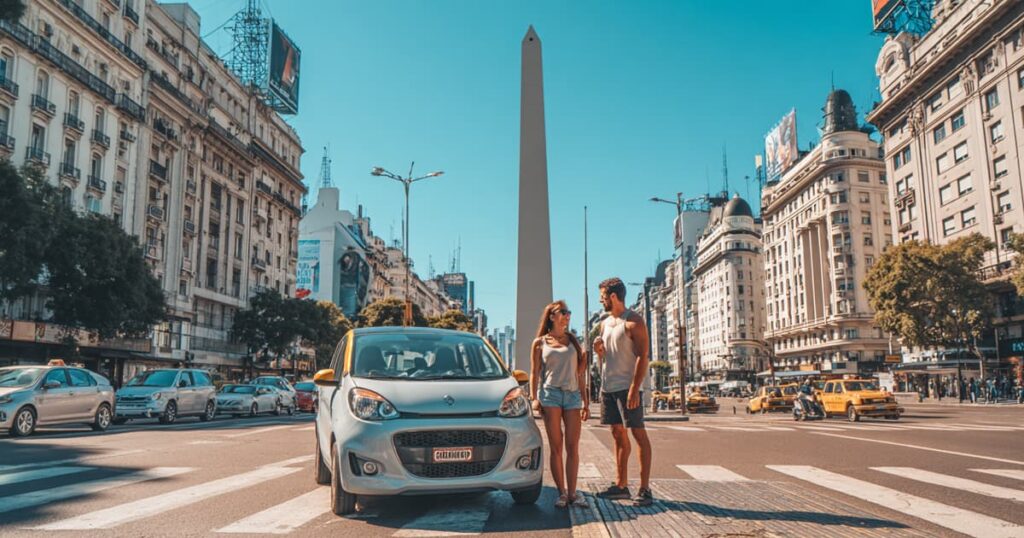
Is It Worth Renting a Car in Buenos Aires? Real Pros and Cons
Imagine landing at Ezeiza Airport eager to explore Buenos Aires at your own pace. You might be asking yourself: is renting a car in Buenos Aires a good idea? The answer isn’t that simple—it depends on your plans. In this article, you’ll discover when it’s worth it, when it’s not, and how to get the most out of it if you decide to rent.
What’s It Like Getting Around Buenos Aires? Public Transport vs. Rental Car
Buenos Aires has an efficient, affordable public transport system with wide coverage. Buses, subways, and trains reach almost every neighborhood. If your plan is to move only within the city, public transportation easily wins.
But if you’re coming with family, a group, or you want to take trips outside the city, renting a car becomes a perfect ally.
Advantages of Renting a Car
- Flexible schedule: you decide when and where to go.
- Ideal for groups or families: you share costs and gain comfort.
- Unlimited getaways: visit Tigre, the Atlantic Coast, or estancias in the Pampas without depending on bus schedules.
Disadvantages You Should Consider
- Heavy traffic: during rush hours (7:30–10:00 a.m. and 5:30–8:00 p.m.), avenues like 9 de Julio or General Paz can be chaotic.
- Expensive and limited parking: 45% of the streets have parking meters (ARS 100–200 per hour), and private garages range from ARS 3,500–7,700 for 24 hours.
- Tricky streets: many are one-way and signage can be unclear if you’re not used to it.
- Extra costs: tolls, fuel, insurance… it all adds up.
Which Areas Are Worth Exploring by Car?
Downtown is better explored on foot or by public transport. But if you already have a car, there are places you can enjoy more when driving:
- Tigre: a weekend classic with its delta and boat tours.
- The Atlantic Coast: Mar del Plata, Pinamar, or San Clemente, 3–5 hours by car.
- Estancias in the Pampas: day or weekend trips to disconnect from the city’s pace.
These getaways from Buenos Aires by car let you discover rural landscapes, enjoy traditional asados, and visit nature reserves that buses and trains don’t reach.
How to Leave the City in a Rental Car
Buenos Aires has several key exits for those wanting to get off the urban grid:
- Acceso Norte (Panamericana): leads to Tigre, Pilar, and the northern region of the country.
- Acceso Oeste: connects to Luján and routes to Mendoza or Córdoba.
- Buenos Aires–La Plata Highway: ideal if you’re heading to the Atlantic Coast or La Plata.
We recommend avoiding departure during rush hour and planning with GPS or apps like Waze. Filling up your tank before hitting the highway is a good idea to avoid crowded gas stations.
Practical Tips if You Decide to Rent
- Choose compact cars: easier to maneuver and park.
- Book early if you want an automatic: they’re limited and cost 20–30% more.
- Get full insurance: to avoid surprises with scratches or minor collisions.
- Use helpful apps: “BA Cómo Llego” or the city’s chatbot “Boti” to check parking zones.
- Keep a map of garages handy: especially if you’re visiting Microcentro, Recoleta, or Palermo.
So, Is Renting a Car in Buenos Aires a Good Idea?
It depends. If you only plan to see the Obelisk, Puerto Madero, or Caminito, it’s better to use public transport or taxis. But if you’re planning to explore the outskirts, travel beyond the usual circuit, or you’re coming with a group, renting a car is an excellent option.
The key is to plan your itinerary well and know the basic traffic and parking rules. That way, you can enjoy Buenos Aires and its surroundings without surprises.
Conclusion
Renting a car in Buenos Aires isn’t for everyone, but it can be a great decision for those who value freedom, comfort, and want to explore beyond the city limits. At Invernalia Rent a Car, we help you choose the ideal vehicle based on your type of trip. Ready to hit the road?
